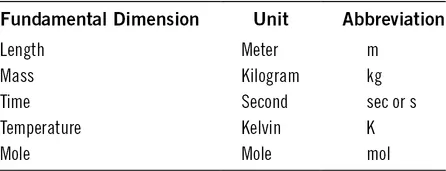
eBook - ePub
Basic Transport Phenomena in Biomedical Engineering
Ronald L. Fournier
This is a test
Condividi libro
- 654 pagine
- English
- ePUB (disponibile sull'app)
- Disponibile su iOS e Android
eBook - ePub
Basic Transport Phenomena in Biomedical Engineering
Ronald L. Fournier
Dettagli del libro
Anteprima del libro
Indice dei contenuti
Citazioni
Informazioni sul libro
- Presents a basic understanding and the theories of transport in biological systems
- Uses real-world applications in the development and design of artificial organs, drug delivery systems, and tissues
- Contributes numerous examples throughout the text with a strong discussion of the numerical methods used
- Updates each chapter with the latest research developments
- Incorporates new problems and selected complete solutions where appropriate
Domande frequenti
Come faccio ad annullare l'abbonamento?
È semplicissimo: basta accedere alla sezione Account nelle Impostazioni e cliccare su "Annulla abbonamento". Dopo la cancellazione, l'abbonamento rimarrà attivo per il periodo rimanente già pagato. Per maggiori informazioni, clicca qui
È possibile scaricare libri? Se sì, come?
Al momento è possibile scaricare tramite l'app tutti i nostri libri ePub mobile-friendly. Anche la maggior parte dei nostri PDF è scaricabile e stiamo lavorando per rendere disponibile quanto prima il download di tutti gli altri file. Per maggiori informazioni, clicca qui
Che differenza c'è tra i piani?
Entrambi i piani ti danno accesso illimitato alla libreria e a tutte le funzionalità di Perlego. Le uniche differenze sono il prezzo e il periodo di abbonamento: con il piano annuale risparmierai circa il 30% rispetto a 12 rate con quello mensile.
Cos'è Perlego?
Perlego è un servizio di abbonamento a testi accademici, che ti permette di accedere a un'intera libreria online a un prezzo inferiore rispetto a quello che pagheresti per acquistare un singolo libro al mese. Con oltre 1 milione di testi suddivisi in più di 1.000 categorie, troverai sicuramente ciò che fa per te! Per maggiori informazioni, clicca qui.
Perlego supporta la sintesi vocale?
Cerca l'icona Sintesi vocale nel prossimo libro che leggerai per verificare se è possibile riprodurre l'audio. Questo strumento permette di leggere il testo a voce alta, evidenziandolo man mano che la lettura procede. Puoi aumentare o diminuire la velocità della sintesi vocale, oppure sospendere la riproduzione. Per maggiori informazioni, clicca qui.
Basic Transport Phenomena in Biomedical Engineering è disponibile online in formato PDF/ePub?
Sì, puoi accedere a Basic Transport Phenomena in Biomedical Engineering di Ronald L. Fournier in formato PDF e/o ePub, così come ad altri libri molto apprezzati nelle sezioni relative a Medicina e Biotecnologia in medicina. Scopri oltre 1 milione di libri disponibili nel nostro catalogo.
Informazioni
Chapter 1Introduction
Before we can begin our study of biomedical engineering transport phenomena, let us first review some basic concepts that are essential for understanding the material in this book. You may have come across some of this material in other courses such as in chemistry, physics, and perhaps thermodynamics. Reviewing these concepts once again is still very important since these concepts form the basis of our approach to analyzing and solving biomedical engineering problems.
1.1Review of units and dimensions
1.1.1Units
Careful attention must be given to units and dimensions when solving engineering problems; otherwise, serious errors can occur in your calculations.
Units are how we describe the size or amount of a dimension. For example, a second is a common unit that is used for the dimension of time. In this book, we use primarily the International System of Units, which is also known by its abbreviation SI, for Système international d'unités. Other systems of units are also used, such as the English and American engineering systems and the centimeter-gram-second (cgs) system. We will come across some of these non-SI units as well in our study. The units of these other systems may be related to the SI units by appropriate conversion factors. Table 1.1 provides a convenient summary of common conversion factors that relate these other units to the SI system.
Table 1.1 Conversion Factors

It is important to remember that in engineering calculations you must always attach units to the numbers that arise in your calculations, unless they are already unitless. Furthermore, within a calculation, it is important to use a consistent system of units, and in this book we recommend that you work with the SI system. In the event that a number has a non-SI unit, you will first need to convert those units into SI units using the conversion factors found in Table 1.1. Also, remember to treat the units associated with a number as algebraic symbols. Then, as long as the units are the same, you can perform operations such as addition, subtraction, multiplication, and division on the like units, thereby combining and, in some cases, even cancelling them out.
1.1.2Fundamental dimensions
The measurement of the physical properties we are interested in are derived from the fundamental dimensions of length, mass, time, temperature, and mole. Table 1.2 summarizes the basic SI units for these fundamental dimensions. The SI unit for length is the meter (m) and that for time is the second (sec).
Table 1.2 SI Units for the Fundamental Dimensions

1.1.2.1Mass and weight
The mass of an object refers to the total amount of material that is in the object. The mass is a property of matter and is the same no matter where the object is located. For example, the mass of an object is the same on Earth, on Neptune, or if it is just floating along somewhere in space. In SI units we measure the mass of an object in kilograms (kg). Remember that the mass of an object is different than the weight of an object. Weight is the forc...